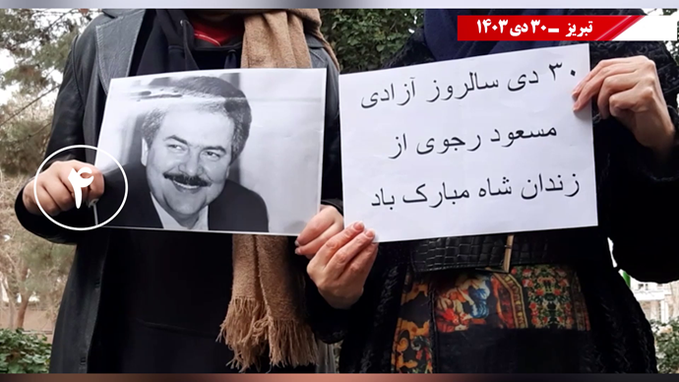20 January marks the anniversary of the release of the last group of political prisoners from the Shah’s prisons in Iran in 1979. Among the 126 prisoners freed that day were Massoud Rajavi and other key members of the People’s Mojahedin Organisation of Iran (PMOI or MEK). This pivotal moment signalled the resilience and determination of those fighting for freedom during Iran’s tumultuous history.
Commemorating the 46th Anniversary
On 18 January 2025, Resistance Units across Iran marked the anniversary with coordinated anti-regime actions, paying tribute to the legacy of those who fought for freedom. These activities included displaying images of Massoud Rajavi alongside inspirational quotes from his speeches, emphasizing the ongoing struggle for democracy and justice in Iran.
The Resistance Units’ activities spanned multiple cities, spreading messages of defiance and hope:
- Tehran (Tehransar Boulevard): “The Iranian people’s democratic revolution will succeed.”
- Karaj (Azadi Street): “The Iranian people’s democratic revolution will succeed.”
- Mashhad (Vakilabad Highway, Saba Boulevard, Amiriyah Boulevard): “The regime must be overthrown entirely.”
- Rasht (Rashtian and Ghali Pour Boulevards): “The revolution is in the hands of its people and insurgents.”
- Bandar Anzali (Jahangardi Street): Visual tributes to resistance.
- Talesh (Salsal Street): “20 January marks the anniversary of Massoud Rajavi’s release from the Shah’s prison.”
- Hamedan (Azadi Boulevard, Baharestan Street, Badi-ol-Zaman Boulevard): “We must break the chains of religious fascism.”
- Sanandaj (Farhangian Complex): “Fight until the chains of religious fascism are broken.”
- Bandar Abbas (Delgosha Street): “You, dictator; I am Arash, fire answers fire.”
Key Slogans in the Fight Against the Regime
On 19 January, Resistance Units intensified their actions, leaving banners, graffiti, and leaflets in public spaces to commemorate the release of political prisoners like Massoud Rajavi.
- Tehran: Slogans included “The era of the uprising and decisive battle has arrived” and “Khamenei and his executioners understand only the language of force and decisiveness,” emphasizing courage and resilience.
- Karaj: Rebels proclaimed, “We will fight until this regime is overthrown” and “We must reclaim Iran by overthrowing the regime entirely.”
- Isfahan: “Death to the mullahs’ regime, long live the Army of Freedom” highlighted rejection of dictatorship and support for organized resistance.
- Mashhad: Slogans like “With the uprising, the sun is about to rise” inspired hope for freedom.
- Yazd: Echoing similar sentiments, slogans underscored the necessity of decisive resistance.
- Rasht: “Rebels roar, surrender is forbidden” reflected unyielding determination.
- Mahabad: “The only path to freedom is to strike back against the regime” symbolized revolutionary spirit.
- Sari: Referencing historical memory, “Ayatollah Taleghani: Torturers were terrified of Massoud Rajavi’s name” reminded people of the enduring strength of resistance.
The Legacy of 20 January 1979
This day marks a turning point in Iran’s history. The release of political prisoners, including Massoud Rajavi, empowered the PMOI and other freedom-seeking groups to assume a central role in the protests that culminated in the 1979 revolution and the collapse of the monarchy.
Today, the Resistance Units continue that legacy, inspiring the Iranian people with their unwavering commitment to a democratic Iran, where human rights, freedom, and self-determination are upheld. Their actions serve as a testament to the enduring spirit of defiance against tyranny and the hope for a brighter future.

